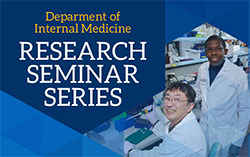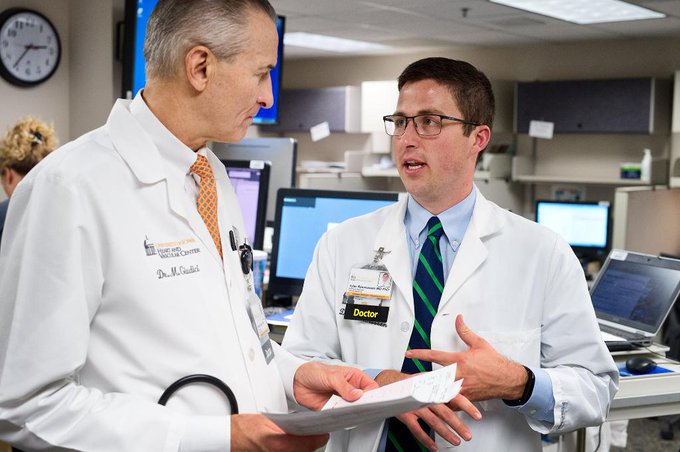Happy New Year, Happy 2020! I hope the past couple weeks have been restorative, whether you were able to take a lot or even a little time away from work and for yourself. The turning of the calendar to a new year and a new decade may be an arbitrary time for the establishment of goals or a restatement of principles, but this period of reflection, one shared by many around the world, lends it an additional importance. This space will continue to evolve, but its core promise of bringing you stories of research, clinical, and educational successes and what they mean for the future of our department will continue to be met throughout 2020 and beyond.
Though the pace around campus has been slow the past two weeks, discoveries and their publications in high-impact, peer-reviewed journals continue to occur. Just this week, the Proceedings of the National Academies of Science published an investigation by a
multidisciplinary team of University of Iowa researchers. The team sifted through millions of de-identified patient records from 2001 to 2017 in an effort to identify whether carriers of the recessive gene mutations that lead to cystic fibrosis (CF) increases the risk for developing CF-related conditions even though the carriers do not actually develop CF. Their results and the publication not only signal that Iowa remains an important center for research into this lung disease, but also exemplifies the power of mining large datasets to advance knowledge. This is a wonderful collaboration between  population scientists and those conducting basic lab-based science. It represents a model of collaboration that is of growing interest to external funders such as the NIH and an opportunity for our clinical faculty and trainees to conduct high quality and impactful research. The methods employed by this team are approaches that can be accessible to many researchers, even those without extensive laboratory training. Our access to large volumes of patient information, particularly within the VA or the insurance database used in the above study, and to tools such as TriNetX represent a great opportunity for fellows and trainees and should be a departmental and institutional focus. This will require new types of research training and mentorship that we will need to nurture within our department. We are clearly in the era of “Big Data” with examples of seminal papers regularly appearing in major journals such as Nature and the New England Journal of Medicine. The department is committed to increasing opportunities for our faculty to grow our research capabilities in this emerging area. However, I believe that a larger institutional investment strategy is imperative to increase Iowa’s competitiveness by strengthening the infrastructure, recruiting talent, and growing the mentorship base to develop the next generation of clinical data scientists.
population scientists and those conducting basic lab-based science. It represents a model of collaboration that is of growing interest to external funders such as the NIH and an opportunity for our clinical faculty and trainees to conduct high quality and impactful research. The methods employed by this team are approaches that can be accessible to many researchers, even those without extensive laboratory training. Our access to large volumes of patient information, particularly within the VA or the insurance database used in the above study, and to tools such as TriNetX represent a great opportunity for fellows and trainees and should be a departmental and institutional focus. This will require new types of research training and mentorship that we will need to nurture within our department. We are clearly in the era of “Big Data” with examples of seminal papers regularly appearing in major journals such as Nature and the New England Journal of Medicine. The department is committed to increasing opportunities for our faculty to grow our research capabilities in this emerging area. However, I believe that a larger institutional investment strategy is imperative to increase Iowa’s competitiveness by strengthening the infrastructure, recruiting talent, and growing the mentorship base to develop the next generation of clinical data scientists.
To increase the exposure of our trainees to research opportunities within the department, representatives from each division will attend two separate residents’ noon conferences later this month to describe the broad range of research being done within their respective groups and opportunities for resident participation. As the residents make decisions about what research project they will perform as part of their curriculum, these sessions should give them a clearer sense of all they can choose from. Thanks in advance to division faculty representatives for taking the time to help our residents in their research choices. Research networking sessions will occur on Wednesday, January 15, and Tuesday, January 28. This represents the efforts of Dr. Brian Gehlbach and our Chief Residents, who have organized this event in the past years. You can read coverage of last year’s sessions here.
An additional plug here, as I am discussing conferences and research, for the Internal Medicine Research Seminar Series, which will kick off its 2020 schedule on Tuesday,  January 14, at 1 pm in the Bean Conference Room (SE301 GH). Our first presentation will be on navigating the Institutional Review Board process from Kelly O’Berry from the Office of the Vice President for Research. In February, the seminar series will revert to its traditional format, showcasing cutting-edge updates from our faculty with two 30-minute presentations during each session.
January 14, at 1 pm in the Bean Conference Room (SE301 GH). Our first presentation will be on navigating the Institutional Review Board process from Kelly O’Berry from the Office of the Vice President for Research. In February, the seminar series will revert to its traditional format, showcasing cutting-edge updates from our faculty with two 30-minute presentations during each session.
Finally, to wrap up this post with evidence that our investments in research training for our clinical trainees pays dividends, let me offer my congratulations to Dr. Tyler  Rasmussen on his receipt of a seed grant from the American Heart Association to use their Get With the Guidelines database to search for patterns in in-hospital cardiac arrests among Medicare recipients. Dr. Rasmussen is a recent graduate of our residency program, the Carver College of Medicine Medical Scientist Training Program, and now a first-year cardiology fellow and member of our Physician Scientist Training Program. Dr. Rasmussen’s hard work and talent of course deserve the primary credit for this and other successes and for the promise his future career shows, but it is difficult not to note just how much training he has received here in Iowa from the excellent mentors and instructors that fill our ranks. I am sure that Tyler will agree that their ongoing input and support made a difference for him as well!
Rasmussen on his receipt of a seed grant from the American Heart Association to use their Get With the Guidelines database to search for patterns in in-hospital cardiac arrests among Medicare recipients. Dr. Rasmussen is a recent graduate of our residency program, the Carver College of Medicine Medical Scientist Training Program, and now a first-year cardiology fellow and member of our Physician Scientist Training Program. Dr. Rasmussen’s hard work and talent of course deserve the primary credit for this and other successes and for the promise his future career shows, but it is difficult not to note just how much training he has received here in Iowa from the excellent mentors and instructors that fill our ranks. I am sure that Tyler will agree that their ongoing input and support made a difference for him as well!